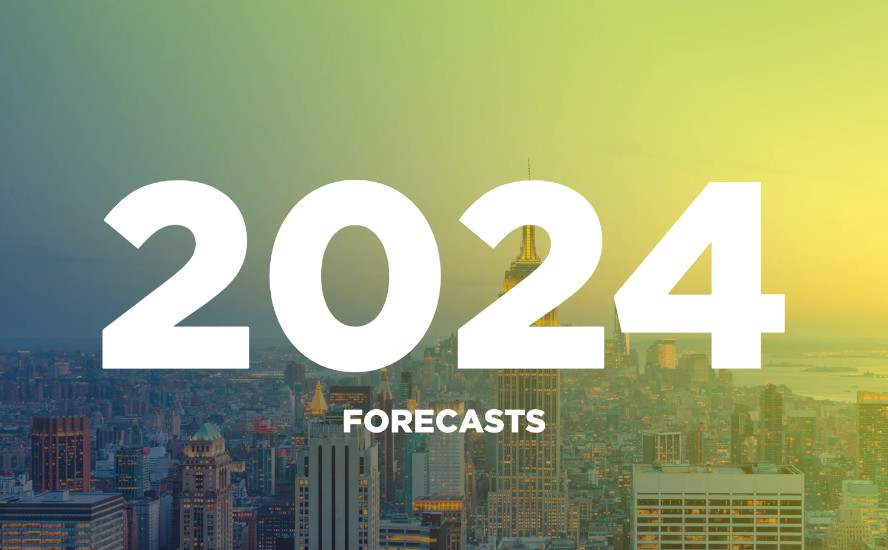Most investors will be happy to consign 2023 to the past. But many of the major themes that occupied their minds this year will linger on in to 2024, based on a survey of the Savills global research network.
The outlook for the global economy will remain a key driver of investor sentiment and deal activity in 2024. This would be true in any given year – real estate is fundamentally a GDP-linked asset – but given the prevailing uncertainty around the future path of growth, inflation, and interest rates, there is perhaps more weight given to the economy at present.
It is therefore unfortunate that, in the words of the IMF, the global economy is merely “limping along, not sprinting.” The resilience that embodied much of 2023 has finally relented to the high interest rate environment, and there is little momentum as we enter 2024. This is certainly true outside of the US, which continues to defy expectations for a more pronounced slowdown (but for how long?). The European economy has stagnated, while weak Chinese growth is weighing heavily on the outlook for Asia Pacific.
IMF GDP growth forecasts
Source:Savills Research using IMF World Economic Outlook (published October 2023)
Nevertheless, expectations of a soft landing, while contrary to historical precedent, remain consistent with incoming data. Inflation is trending downwards despite continued strength in labour markets, and there remains no obvious catalyst that would trigger a more severe downturn. Furthermore, with interest rates peaking, the first pre-condition for stability has been met, which should help to facilitate a floor in real estate pricing, and eventually a recovery in investment activity.
However, central banks continue to caution against expectations of a quick about-turn in policy rates, and adapting to ‘higher for longer’ will necessitate pain for some investors. But there is a trade-off between taming inflation and supporting growth, and as we move through the year, the focus will inevitably shift towards the latter, prompting central banks to begin cutting rates from mid-2024. In real estate, the old adage that ‘timing is everything’ holds truer than for many other markets. Get through the next six months unscathed, and we can expect a positive shift in sentiment and activity.
But to focus on the economy is to ignore a myriad of other key drivers of value in real estate. While acknowledging the potential for recency bias, it is difficult to identify another period of such rapid structural change across so many dimensions, including the environment, technology, and geopolitics, amongst others – certainly, at least, for the current generation of real estate investors.
Behind the economic environment, our survey ranks demographic and behavioural considerations as the second most critical theme for real estate investors. This is most pertinent for the living sector, driven by demographic change and urbanisation, which determine the type of product in demand for each region.
Fortunately, demographic outcomes are much easier to forecast than economic outcomes, and indeed, future legislative changes. The living sector is particularly sensitive to legislation. Many governments are contemplating rent regulations as a means of improving housing affordability, which if implemented sensibly, can provide security to both tenants and investors, but if too onerous, risk exacerbating existing supply shortages by deterring new development.
The environment is the next key theme highlighted by our research network. The office sector is already seeing a growing dislocation in outcomes across both capital and occupational markets based on the green credentials of buildings. Obsolescence risk is rising, particularly in Europe where legislation is targeting the energy performance of commercial buildings, providing both challenge and opportunity for investors over the next 12 months.
Technology often acts as a disrupter in real estate; in the retail sector, it was the emergence of e-commerce, while in the office sector, it was the rapid development in remote working capabilities trigged by the Covid-19 pandemic. Of course technology can be a force for positive change also, and there is great excitement over the potential for generative AI, for example, to enhance the sustainability of buildings, or to improve the efficiency of logistics facilities and combat labour shortages. For investors, opportunities abound in developing the infrastructure that will facilitate this growth.
Geopolitics has quickly permeated the boardrooms of multinationals trying to negotiate an increasingly fractious world. This is most relevant for the logistics sector, which will need to adapt to shifting global supply chains and respond to increased momentum behind trends such as nearshoring and friendshoring. With around 40% of the global population set for a leadership election in the next 12 month, geopolitics will continue to underpin market volatility next year. Cross border investors will need to consider geopolitical factors when deploying capital.
Finally, while environment continues to lead the ESG agenda, the ability of real estate to deliver social value is increasingly recognised as a driver of financial returns and future-proofing assets. Expect continued development in this area, including efforts to create a recognised benchmark similar to those available in the environmental space.
Which themes will have the greatest influence on real estate investment in 2024?
Source:Savills Research



